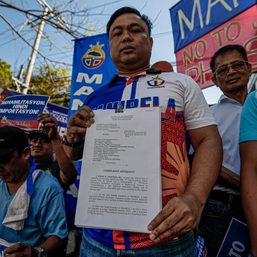SUMMARY
This is AI generated summarization, which may have errors. For context, always refer to the full article.

MANILA, Philippines – The Philippine justice system is far from perfect – and that’s the reality.
According to criminology expert Raymund Narag, the Philippines has one of the longest litigation periods in the whole world. Detained persons stay behind bars for an average of 528 days before their cases are solved. Some stay for around 15 to 20 years and still await verdict for their cases.
A total of 308 courts out of 2,692 authorized courts were listed as vacant, as of September 2021. An additional 143 courts were tagged as “unorganized,” and 120 judges were “retired,” which result in 21% of courts in the whole country being unoccupied.
Some judges in Dagupan, Pangasinan hold hearings in corridors of establishments to ensure that justice is being facilitated. Another judge would write his decisions inside his own bahay kubo (nipa hut), and not in the judges’ “chamber” as should be.
Over the years, the Supreme Court has experimented with small- to large-scale reforms, like a mobile court, and the averted Enterprise Information Systems Plan (EISP), which was a digitization project hounded by controversies during the time of ousted chief justice Maria Lourdes Sereno.
Supreme Court Associate Justice Maria Filomena Singh admitted that even she, as a young lawyer, “believed that law practice and the judicial system was hopelessly inefficient, inept and unresponsive to the needs of the people.”
The Supreme Court, in another bid to fix long-standing problems, launched the Strategic Plan for Judicial Innovations or the SPJI last year and according to Singh, they have “already accomplished a lot.”
“There is still much to be done. This is a five-year plan. We are only going on to year two,” Singh said on Monday, October 16, for the one-year report.
AI?
Chief Justice Alexander Gesmundo announced that they are looking into using Artificial Intelligence or AI to improve court processes like transcribing proceedings. AI-enabled voice-to-text transcription technology will be piloted in 20 courts, said Gesmundo, but the machines will first have to learn the different languages, dialects and accents in the Philippines.
“We were able to see how these voice text system works and the first thing that we learned there is that you have to have a good microphone, a microphone [that] can identify who is speaking because if you don’t have a good microphone, you will have difficulty doing that voice-to-text transcription,” the Chief Justice said.
Court stenographers will not lose their jobs, said Gesmundo, and would instead undergo training to use the technology.
“For sure we will train our people and we will redo their skills. That is our commitment. Text-to-voice will not eliminate the job of stenographers but will make them more efficient and reliable,” Gesmundo explained.
Kiosks and social media
Once hesitant to go all out with its communication plans and believing in the dignity of silence, the SC said it will launch its own social media information sites that will use less legalese and more “user-friendly language.”
English and Filipino, including local languages, will be used in these sites to explain processes, like how to post bail, including the amount of filing fees that need to be paid and where to pay them.
“In time, AI-enabled platforms for self-help and public assistance services will also be deployed. The Court will put up kiosks in precincts and courts,” Gesmundo said during the SPJI anniversary.
Senior Associate Justice Marvic Leonen said several projects have already been completed, including:
- Philippine Judiciary Online Learning Platform
- Judiciary Enterprise ICT (information and communications technology) Governance Framework
- Strengthened Legal Aid Initiatives
- Adoption of Guidelines for the Use of Gender-Fair Language in the Judiciary and Gender-Fair Courtroom Etiquette
- A Study on Gender Representation and Mobility in the Philippine Judiciary.
– Rappler.com
1 comment
How does this make you feel?










Deep appreciation to the Supreme Court of the Philippines under the leadership of Chief Justice Alexander Gesmundo for these initiatives under the Strategic Plan for Judicial Innovations (SPJI). In particular, the interest in applying Artificial Intelligence or AI to improve court processes is indeed praiseworthy. We also need information about the other several projects which have already been completed as mentioned by Senior Associate Justice Marvic Leonen. I hope that the Supreme Court will regularly update Rappler readers about these developments under SPJI especially the mentioned application of AI.